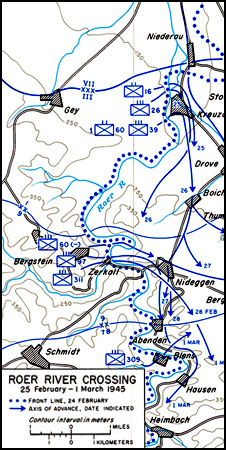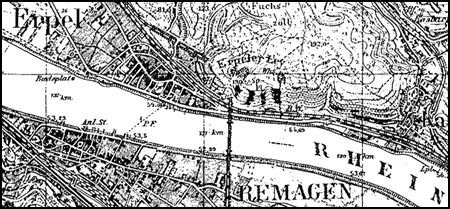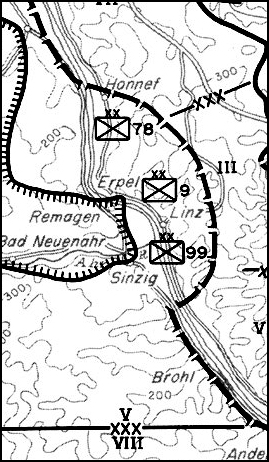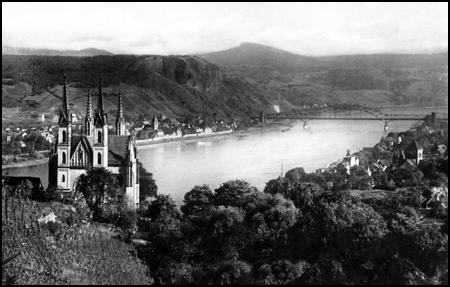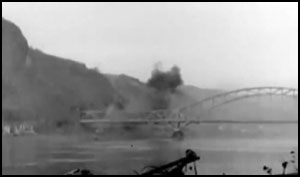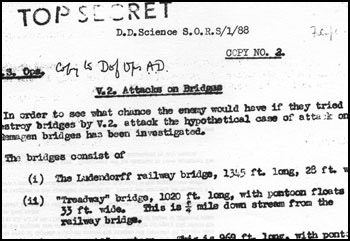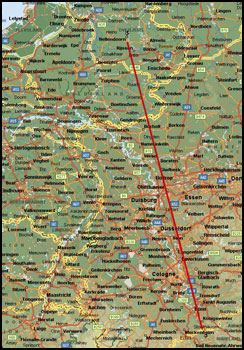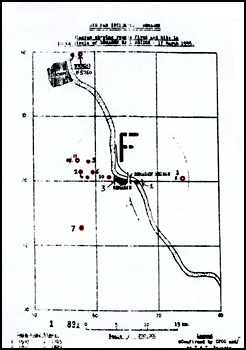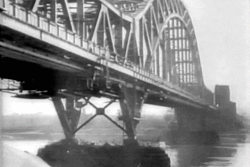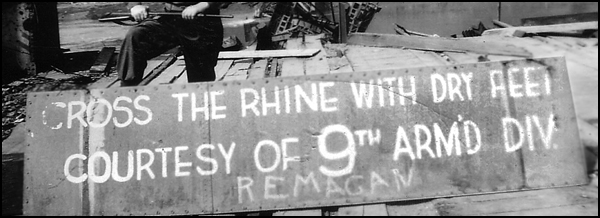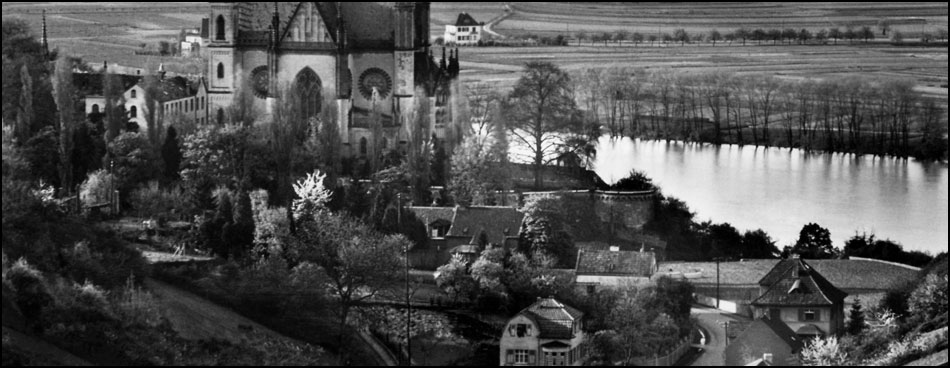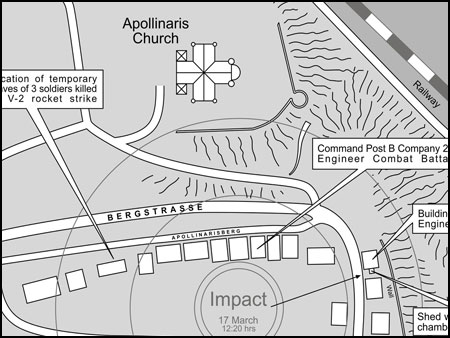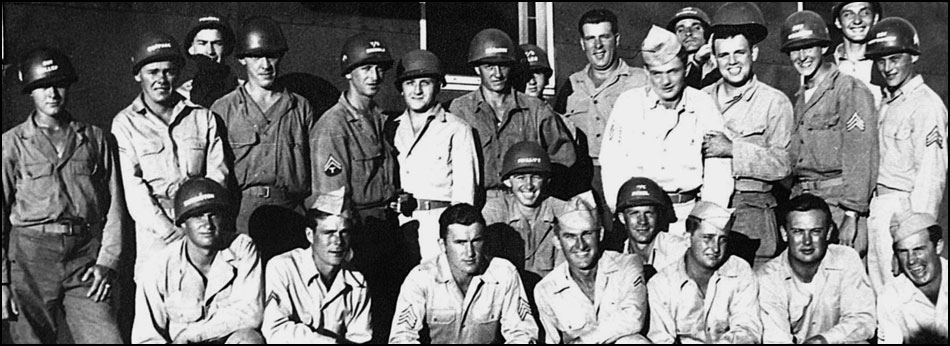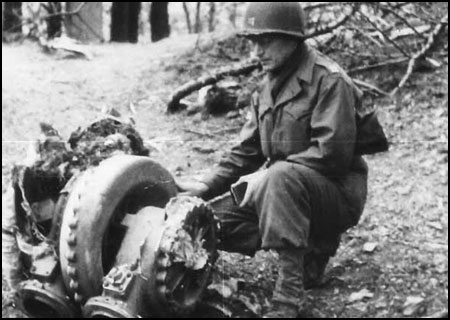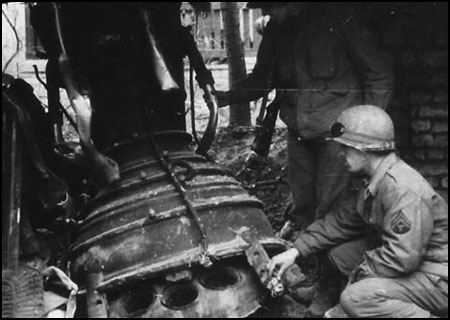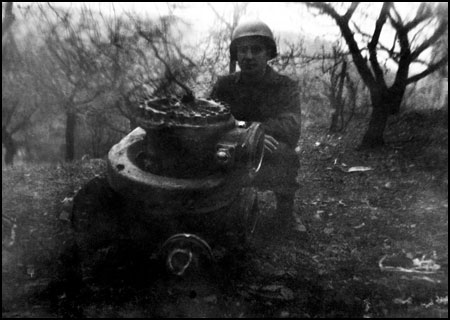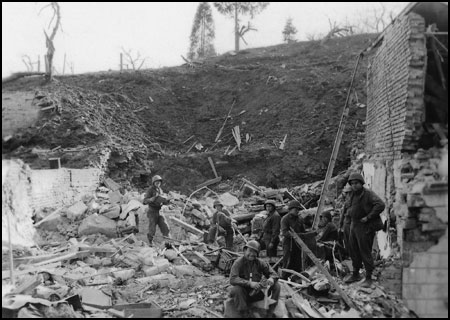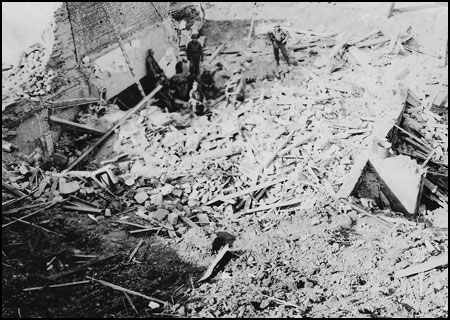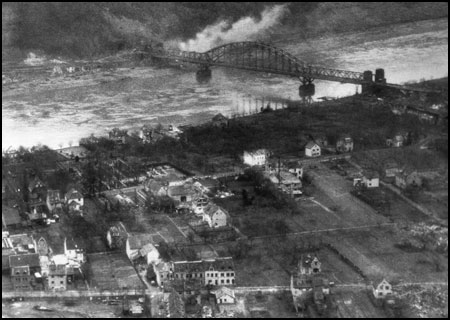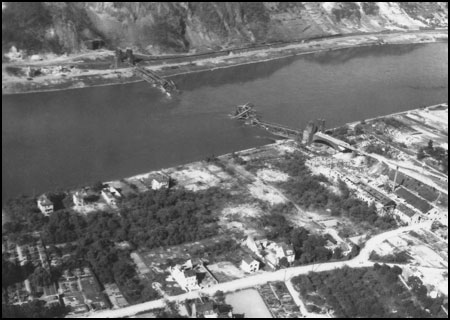V2ROCKET.COM - Rockets On Remagen; V-2 and the Ludendorff Bridge
- ️Tracy Dungan
(Special thanks: Mikel Shilling, Detlev Paul, and Wolfgang Gückelhorn)

The events leading up to the capture of the Ludendorff Bridge at Remagen in March 1945, and the fierce fighting and unconventional German counterattacks that followed, have been overlooked in most accounts of the battle. The crossing of the bridge at Remagen by the Americans was only part of the story as the GIs moved into the Westerwald region of the Rhineland. Hitler's insistence the Ludendorff Bridge be destroyed by any means resulted in the first tactical use of the V-2 ballistic missile against a strategic target. Also, the Allied advance in the region, along with dwindling rocket fuel supplies, resulted in the retreat of V-2 Battalion 836 (Art. Reg. 901) from the Westerwald area.
|
We
were across the Rhine, on a
permanent bridge; the
traditional defensive barrier
to the heart of Germany was
pierced. The final defeat of
the enemy, which we had long
calculated would be
accomplished in the spring and
summer campaign of 1945, was
suddenly, now, just around the
corner.
General Dwight D. Eisenhower As Lieutenant Karl Timmermann looked out from his vantage point on top of a hill to the northwest of Remagen, Germany, he was stunned to see a beautiful steel structurea still-standing railway bridge over the Rhine River. As he peered through his binoculars, Timmermann could see thousands of fleeing German soldiers and civilians. Wehrmacht troops had already prepared the bridge for demolition. The masses were crossing to the east in an attempt to escape the American forces that were descending on the resort town of Remagen. It was March 7, 1945. A cold, gray, chilly day. It was only hours before, because of casualties among ranking officers, that Timmermann, from West Point, Nebraska, had been promoted to commanding officer of Company A, First Battalion, 27th Armored Infantry Regiment, 9th Armored Division. Timmermann's company represented the lead elements of a large American push to the Rhine. They had arrived at a high point overlooking the scenic resort town on the west bank of the Rhine River, halfway between Cologne and Koblenz. |
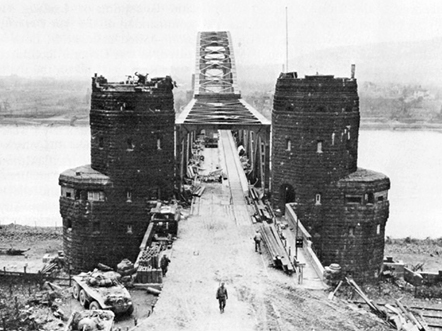 |
Ever since it had crossed the border farther north a few weeks earlier, the 9th Armored had been locked in fierce fighting against German resistance. They had seen comrades wounded, maimed, and killed. Timmermann's men were exhausted, cold, angry, and frightened. There seemed to be little reason for unwarranted heroics, no one wanted to get killed now, since it seemed Allied victory was inevitable.
Major General John W. Leonard's 9th Armored Division had left Fort Riley, Kansas, in August 1944. They crossed the Atlantic on the Queen Mary liner, and then spent September in training in England. After crossing the English Channel, the 9th joined the fight during the Allied drive eastward across France. Many of the men felt they had already experienced their fair-share of combat. During the German counterattack in December 1944the Battle of the Bulgeportions of the 9th Armored and been used to fill gaps in Allied front lines.
Following the battle in the Ardennes, the Allies began steps for the final assault into Germany. The Siegfried Line and the Rhine River were the last great barriers into Germany. The long-delayed US Army thrust over the Röer River, Operation Lumberjack, finally took place in February, placing the US Army along the Rhine. The Rhine represented the last major geographical barrier to the Allied advance into Germany. The 9th Armored Division had been in training during the early weeks of 1945. They returned to the front lines in late February joining III Corps as it prepared to cross the Röer River. The First Army was headed to Cologne and the industrialized Ruhr Valley. In the greater scheme, Montgomery's troops were given the task of forging a Rhine crossing north of the Ruhr in February, and the Americans were given a supporting role. The 9th Armored was part of 12th Army Group, under Lieutenant General Courtney Hodges First Armysouth of Field Marshal Bernard Montgomery's British 21st Army, and north of Major General George Patton's Third Army. Each of these were moving eastward towards Nazi Germany with enormous supply lines behind them.Bradley's 12th Army Group would support General Montgomery by capturing dams on the Röer River and then pinching the Germans into a trap west of the Rhine. Supporting the attack to the Rhine, the 9th Armored's job was to push across the Röer. However, the Germans countered by demolishing the Röer dams and flooding the valley. This made the Americans progress dangerous and slow.
Month's earlier; the purpose of General Montgomery's Operation Market Garden had been to capture bridges over the Rhine River. While some Allied commanders had given up any aspirations, a small contingent of Allied officials still held out hopes of capturing an intact bridge over the Rhine. It was in February of 1945 that General Milliken's III Corps, part of Hodge's Army Group, asked if there were any remaining bridges over the Rhine? Milliken was told there would be no bridges remaining intact by the time he reached the Rhine River. The Germans were demolishing them before they could be captured by Allied forces. Just as predicted, on March 2nd two Rhine bridgesone at Oberkassel, near Düsseldorf, and another just south of Uerdingenwent up in a cloud of smoke as the Americans approached.
Two standing bridges over the Rhine were discoveredone at Bonn and another about 12 miles south at Remagen. Both bridges were in the zone of the III Corps. American commanders began planning a quick thrust in the hopes of capturing at least one of these spans intact. However, the Germans were fully aware of the American aspirations to capture a bridge. For the men in charge of the demolition the timing was sometimes precarious. With German troops in retreat, the bridges could not be blown too early as this would trap German forces on the wrong side of the river. The demolition could not be postponed too long, lest the Germans risked enemy capture of the bridge.
The Ludendorff Bridge was
designed to connect the Right Rhine Railway, the
Left Rhine Railway and the Ahr Valley Railway
(Ahrtalbahn) to carry troops and supplies to the
Western Front. The 4,640-ton structure cost about
2.1 million marks during World War I. Since the
bridge was a major military construction project,
both abutments of the bridge were provided with
fortified foundations. These towers were equipped
with loopholes for the bridge crew, storage, and
accommodations for troops. From the flat roofs of
the towers there was a wonderful view over the
valley.
During the
design of the Ludendorff Bridge, the
architect was ordered to accommodate the use
of demolition methods, in case of eminent
enemy capture. The two bridge piers were
built as hollow shells, complete with
demolition chambers. Explosives could be
installed at the base of the piers in case
it came under attack. Electrical circuits,
protected by steel tubing, had been included
so engineers would be able to detonate the
bridge from the safety of the rail tunnel
beneath the Erpeler Ley. After WWI, French
authorities filled the demolition chambers
with concrete. In 1938 German engineers took
steps to prepare the bridge once again for
an emergency demolition. Zinc-lined
explosives containers were installed at key
structural points, while ignition wiring was
laid in steel tubing. In addition, primer
cords that could be ignited by hand were
installed as a backup. The bridge should be
easily destroyed with minimal preparation.
There were several men defending
Remagen whose names would forever be linked to the
story of the Bridge at Remagen. Captain Karl
Friesenhahn was the German engineer in charge of the
small group of men whose job it was to destroy the
Ludendorff Bridge at the precise moment to prevent
its capture. Captain
Willi Bratge, a
decorated German officer, was the military
commander in charge of defense of the bridge.
At his disposal was one company of
the German 80th Infantry Replacement and Training
Battalion. The men under
Captain Bratge were convalescing soldiers. Over
the winter months Captain Bratge managed to
build a series of outposts along the
Victoriasberg heights west of the town. He also
set up a guardroom in the Waldberg Hotel
overlooking Remagen. Flak units were deployed on
the heights to defend the bridge, along with
1/535th Heavy Railway Detachment. As the winter
ground begin to thaw, the people of Remagen
noticed increased military activity in the area.
They knew soon the battle would come to their
homes. At the end of February Bratge was
informed that they would, in future, report to
Lieutenant General Botsch of the Field Army, the
new commandant for the stretch of the Rhine
between Bonn and Remagen. Fifth Panzer Armys
take over from XII Army Corps was further
complicated by a reorganization of the front
line.
9th Armored was now part of Combat Command B under III Corps, supporting the infantry as they advanced towards the Rhine. The "combat command" was a flexible organization that did not have dedicated battalions. Instead, tank, armored infantry, and armored field artillery battalions, as well as smaller units of tank destroyers, engineers, and mechanized cavalry were assigned as needed in order to accomplish any given mission. Brigadier-General William M Hoge ordered his troops to split into three armoured columns and managed to establish a bridgehead across the Neffel River, battling German rearguards along the way.
The columns managed to reach Neiderberg on March 2, and captured a bridge in the center of the town. Turning south, Combat Command B went through Bodenheim and managed to cross the Erft and take Wuscheid and Grossebullesheim easily. The Germans were in retreat as 52nd Armored Infantry Battalion joined Combat Command B ready for the final stage of the advance to the Rhine.German General von Botsch traveled to the Rhineland to inspect the troops in early March. He discovered in Remagen that Captain Bratge had only thirty-six men, along with a handful of engineers and AA gun crews, to defend the bridge. Bratge would need more men. On March 5, 1945, von Botsch promised to send a battalion of men to assist Bratge. However, on March 6, the 9th Armored was already just eight miles from the Rhine.
Combat Command B advanced
through the town of Esch as the 27th
Armored Infantry Battalion advanced
towards Morenhoven. As Combat Command B
entered Flerzheim they saw white flags
hanging from the windows as found the
German troops had fled. Ahead lay the town
of Stadt Meckenheim. 27th Armored Infantry
Battalion came under fire as it entered
the town, but resistance quickly came to
an end. Brigadier-General Hoge set up his
headquarters in the town. Stadt Meckenheim
had been devastated by Allied bombing
attacks. Engineers had a big job to clear
the streets of rubble to make way for the
vehicles to pass. Meanwhile, in Remagen,
German troops were streaming over the
Ludendorff Bridge to escape the American
spearheads.
The next morning, March 7, Hoge decided to split his command into two task forces, each one comprising of a mix of tanks and infantry mounted in halftracks. Because of the light resistance the tanks could expect to reach the Rhine River by afternoon. Armored cars of the 89th Reconnaissance would scout the roads ahead. Whenever a German rearguard was located, the poorly equipped enemy usually surrendered with little resistance. Combat Command B had two objectives. Moving southeast, they should capture the crossings over the River Ahr at Bodendorf and Sinzig. The Division would then be able to continue to push south along the Rhine towards Seventh Army. The next objective objective was to clear the west bank of the Rhine near Remagen.
No one really believed the bridge would actually be standing much longer, so the orders didnt even mention a bridge as the objective.
The 52nd
Armored
Infantry
Battalion,
under the
command of
Lieutenant-Colonel
William M
Prince, would
lead the
southern
column. Tasked
with securing
bridgeheads
over the Ahr
River at
Westum and
Sinzig, the
52nd moved out
shortly after
7:00 AM.
Because of
heavy rubble
in the roads
from the
bombardment,
the planned
route had to
be altered
with Princes
column
re-routed
south via
Gelsdorf and
Eckendorf, and
then rejoining
its prescribed
route at
Fritzdorf.
However,
Engeman's 14th
Tank Battalion
was forced to
wait while
engineers had
cleared the
road to
Adendorf of
rubble.
Both columns progressed at a steady pace making good time. As they approached each town with care, they were happy to find no signs of German rearguards. Each village and town was entered with no opposition.
By the time the 52nd Armored column reached Fritzdorf, the recce element was able to begin scouting ahead. By 9:00 AM the column had reached Oeverich and then Kirchdaun, where some of the lead vehicles became stuck in the mud. Lieutenant-Colonel Prince decided to reroute the rest of the column through Gimmingen to the south. Resistance came from Germans in the local church tower, but was soon silenced. The 52nd continued through Heppingen, Bodendorf, and towards Sinzig. It was in Sinzig that the 52nd Armored captured a bridge over the River Ahr. As the columns approached the town they were met with enemy fire from prepared emplacements. The 75mm guns of the Sherman tanks took care of this and the American halftracks and infantry pushed into town. German engineers attempted to blow the bridge, but the demolition charges failed. The Americans were quickly over the bridge and captured the town. By 1:00 PM Lieutenant-Colonel Prince's columns had taken all of their objectives. He reported 75 enemy killed and close to 400 captured.
With the sounds of guns and shellfire
getting closer, Major Hans Scheller arrived on this
scene around 11:00 AM. He found Captain Bratge still
directing traffic. He immediately informed Bratge of
his orders to assume command of combat troops.
Bratge was at first relieved, because he thought
this was the long-awaited assistance Remagen had
been waiting for. But his hopes were dashed when
Scheller informed him there were no reinforcements
coming.
Smashing their way through half-hearted resistance, the Americans were only a few miles from the bridge. At the front of the advance, Timmermann could see through his binoculars the bridge cluttered with soldiers, civilians, vehicles and even livestock. Timmermann sent a runner off to Col. Engeman with a request for tanks and artillery, but the request was turned down. Instead, the battalion was ordered to keep moving forward in attack. Coming down through the hills over-looking the northwest of Remagen, Timmermanns company and a handful of tanks steered their way cautiously through the narrow streets of the old city.
The infantry cleaned out the town in 2 hours.| |
As the Americans approached the western side of the bridge, a deafening explosion sent earth and rocks skyward. Captain Friesenhahn had just set off his first charge that took out a 30-foot section of the stone archway that connected the approach embankment with the steel bridge. Through his binoculars, Timmermann could see the German engineers scurrying about making final preparations to bring the bridge down. The Americans moved on up, so as to have a good view of the pyrotechnics show. Just then, orders came down on the radio from General Hodges to take the bridge. Hoge had a report from captured German soldiers that stated the bridge was to be blown up at 4:00 PM. Hoge informed Engeman to speed up attack, it was then about 3:30 PM. At the same time, Captain Friesenhahn was making final adjustments and could blow the bridge at any moment. The battalion commander asked Timmermann, "Do you think you can get your company across that bridge?" Timmermann responded, "Well, we can try. What if the bridge blows up in my face?" The battalion commander didn't answer, he just walked away. |
When
Friesenhahn blasted the
approaches, it was a sign to
Captain Bratge that the
Americans were close to crossing
the bridge. When Friesenhahn
made it back to Bratge, and
reported the Americans were at
the steps of entering the
bridge, Bratge said, "Blow up
bridge now!" Friesenhahn said,
"I cannot, only Major Scheller
can give the order!" At that
moment, Major Scheller was on
the other end of the Erpeler Ley
tunnel, more than 1,000 feet
away from Bratge.
Bratge dashed off and ran to the
other end of the tunnel where he
told Scheller, "If you don't
give the order to blast the
bridge, I will do so myself!"
Scheller quickly replied, "Then
go ahead and blast the bridge."
Minutes past before Bratge could
run back to within earshot of
Friesenhahn. He yelled out to
him, "Friesenhahn,
blow
the bridge!"

Photos
below: Views of Remagen and the
Ludendorff Bridge in March of
1945. Gen. Hoge made decisive
decision to take the bridge.
(CLICK ON THUMBNAIL TO ENLARGE)
 |
 |
 |
 |
 |
 |
 |
 |
 |
 |
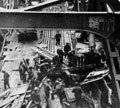 |
 |
 |
 |

From the west bank the available tanks and artillery began shelling the entrance to the Erpeler Lay railway tunnel on the opposite side. Timmermann shouted to his men, Alright, were going across! His men, although leery of their suicide mission, rose to their feet and moved forward. Friesenhahn could see the American soldiers approaching. Friesenhahn shouts, "Full cover, full cover!" Everybody in the tunnel lies down on the ground in order to escape the tremendous blast that is about to occur. On Major Schellers order, he took hold of the firing mechanism, made last connections, and twisted the handle. Instead of an explosion, the bridge sat motionless; there was nothingnothing except the sounds of American shells bursting around the tunnel entrance.
Just as Company A started towards the bridge
again, machine gun fire from one of the stone
towers on the west bank pinned them down. American
tanks close by quickly obliterated that threat.
Timmermann and his company rushed onto the bridge.
A platoon of Pershing tanks provided cover against
German machine gun fire coming from towers on the
east end of the bridge, the infantrymen rushed
forward, zigzagging from girder to girder. They
were joined by American engineers from
2nd Platoon, Company B, 9th Armored
Engineer Battalion (Lieutenant Hugh Mott,
Staff Sergeant John Reynolds, and Sergeant
Eugene Dorland)
who were locating and severing the wires to
additional unexploded charges. All the while,
small arms fire from the Germans was glancing off
the girders around them.
|
American tanks on the west bank opened up
on a German barge that was submerged about
200 yards up river off the east bank.
Shells quickly silenced the sniper fire
coming from the barge. However, the
American assault of the bridge had bogged
down. A
portion of the catwalk had been
severed on the upstream side, at
the east bank pier, where the
bridge demolitions had exploded.
The men were very apprehensive of moving
forward with lack of cover, all bunched
together. One of Timmermann's platoon
leaders, Sergeant Joe DeLisio, got moving.
Gallantly, DeLisio ran forward in the hail
of bullets. Screaming orders, Timmermann
followed after him, which prompted the
others to keep moving too.Bratge
again ran back through the tunnel to
Scheller to report the failure of the
detonation, but soon calls for Bratge
beckon him. He runs again through the
huddled masses of men, women, and
children, and as he arrives
Friesenhahn yells, "Americans on the
bridge!" Bratge calls out,
"Counterattack! We must throw them
back, there can't be many of them!"
The shell fire at the entrance to the
tunnel prevents this. Bratge looks for
more men, any soldiers in the tunnel.
Bratge wonders why Major Scheller's
Lieutenants are not coming forward to
help in the fight?" He soon discovers
that Scheller and the two lieutenants
have fled the area from the opposite
end of the tunnel. Across the bridge, DeLisio made it to the base of one of the stone towers on the east bank. He kicked in the door and ran up the stairs, surprising three Germans huddled around a jammed machine gun. They immediately surrendered and DeLisio threw the machine gun from the window of the tower. Seeing this, the other men rushed the second tower and secured it too. |
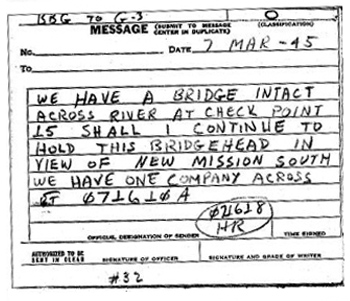 |
Bratge
intended to get all
available men out of the
tunnel and gather
together near Osberg and
launch a counterattack.
But as they started to
leave the tunnel on the
far side of Erpeler Ley,
gun fire and hand
grenades met them. The
Americans had crossed
over the mountain and
found the tunnel exit of
the other side. Bratge
can hardly believe the
Americans crossed the
mountain so fast.
The Americans were now across the Rhine. Sergeant
Alexander A. Drabik of Holland,
Ohio, was the first American soldier
to cross this bridge.
The infantry formed a defensive perimeter
while the engineers continued cutting wires
and disabling charges. Timmermann and
DeLisio concentrated on clearing out any
threat still remaining from within the
railway tunnel. Making their way
from the bridge to the tunnel entrance, and
then further inside, they made their way
cautiously in the dark to the bend. DeLisio
and his men can hear German voices not far
away. They threw a few hand grenades and fired
a few bursts. Soon a stream of German soldiers
and civilians, hoisted a white flag, and
exited the tunnel.
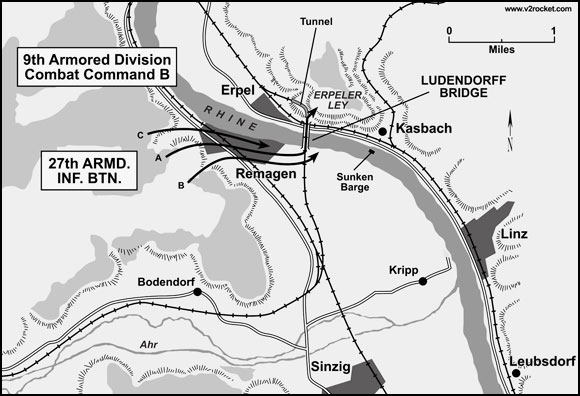 |
Later that evening, when word of the
bridge's capture reach Allied commanders,
the US First Army began funneling all
available troops towards Remagen.
Motorized regiments from the 9th and 78th
Infantry Divisions, joined by a number of
other units, were routed to the bridge
crossing. The Americans were going to
secure their hold on the bridge as soon as
possible. After engineers had erected a
Bailey bridge spanning the section of the
blown approaches on the west side of the
bridge, a platoon of tanks and tank
destroyers were sent over. However, by
midnight, only 5 tanks had made it across,
this was because one of the tank
destroyers had fallen through a hole in
the planking. At 03:00 hrs it was pushed
through the bridge into the river and
vehicles began to cross again. As soon as the news came that the Americans were over the Rhine, Hitler ordered the immediate destruction of the bridge using any and all means possible. German counterattacks that night were fierce. Reserves were brought up to at least try and destroy the bridge. The American tank crews, in some cases, were throwing hand grenades from their hatches as the German infantry were right on top of them. Their orders were to hold their groundeven if their tanks were shot out from under them. By daybreak the counterattacks were beaten back. Even so, on March 8, the Germans attacked with two (under-strength) panzer divisions. The 9th and 11th Panzer Divisions hurried to engage the American 9th Divisionthe objective being to push the Americans back across the Rhine and destroy the bridge. |
These efforts
were stopped by the units of the 9th and
47th Infantry Regiments. Nearly 1,000
troops, along with tanks and artillery,
had crossed the bridge by nightfall.
Company A
of the 14th Tank
Battalion, using the new
90mm guns of the M26
Pershing tanks, had the
range needed to take on
the counterattacking
German armor on the east
bank.
| |
That same day ten
Luftwaffe
aircraft,
including eight
Ju-88 Stuka
dive-bombers,
attacked the
bridge, scoring
two close hits.
However, three of
the Stukas were
shot down and
probably most
received damage.
Luftwaffe
chief Hermann
Göring had
asked for
volunteers to
fly a suicide
mission
against the
bridge. Many
volunteered,
but the idea
was dismissed
when it was
explained the
bombs could
not be armed
while attached
to the
aircraft.
The Stukas
approached
from the south
along the
river around
3,000 feet.
The radars
easily
acquired them
at that
altitude, and
90mm
anti-aircraft
guns fired
away. Despite
the AAA fire,
the bombers
took no
evasive
action. Some
jettisoned
their bombs
before
reaching the
bridge, and
one or two
bombs did fall
on the western
approach to
the bridge.
This would be
as close as
the Luftwaffe
would come to
the bridge
that day.
This action
started a
great rush of
anti-aircraft
artillery to
the Remagen
area. In a few
days, the
whole area was
a giant mass
of
anti-aircraft
units. 37mm,
40mm automatic
cannon, and
90mm
anti-aircraft
guns ringed
the area.
Although the
presence of
hundreds of
antiaircraft
guns and
machine guns
ultimately
ensured the
bridge's
safety, the
full strength
of the
anti-aircraft
buildup
associated
with Remagen
did not occur
until March
10, 1945. However,
before this
buildup, the
Luftwaffe
launched air
strikes that
had an
excellent
chance to
destroy the
bridge. The
remarkable
story of
Remagen
defense was
the
establishment
of the initial
defenses
around the
bridge in the
first 72
hours, not the
huge buildup
that followed.
The battalions
added to the
defense after
March 10 were
a statement of
resolve,
rather than
necessity. |
|
The
Luftwaffe's
response to
counter with
quick air
attacks was
the right one.
Even the use
of the
outdated Ju-88
dive-bomber
was the
correct
decision.
Despite heavy
losses, the
Stuka was
probably the
one aircraft
that could
have brought
the bridge
down early on.
Given the
weakened state
of the bridge,
just one
500-pound bomb
delivered
against a
girder or
weakened truss
could have
caused the
entire
structure to
collapse. But
after the
unsuccessful
mission of
March 8, the
Luftwaffe
decided to use
its most
modern
aircraft to
attack the
Ludendorff
Bridge. On March 9 an assortment of German aircraft were sent to attack the bridge. Early that morning, these included the Fw-190, Bf-109, and Me-410. Later in the day, III./KG76 flew sorties against the Remagen bridge. Three Arado Ar-234 jet-bombers were sent, along with some Me-262s flying cover. But the AAA was very heavy and one Ar-234 was shot down, one other reported missing. On March 11 two more Ar-234s from III./KG76 attacked the bridge. On March 12 four Ar-234s came over at noon, followed by twelve more, escorted by Me-262s flying cover, later that day. The next day nineteen Arado jet-bombers attack again without success. On March 10, 1945, a decision was made to build two temporary ponton bridges spanning the river. Repairs were needed on the Ludendorff Bridge, but the Allies did not want to slow the movement of thousands of troops and supplies over the Rhine and into Germany. Under German fire and Luftwaffe attacks, the 51st and 291st Combat Engineer Battalions began constructing a ponton and tread-way bridge, as well as a ferry system with pontons and landing craft to put even more Allied troops, tanks, and weaponry over the Rhine. While the M26 Pershing tanks were too heavy to cross the bridge, they were soon across using the new ferry system. During the following days several divisions were ferried across the river. The area of the bridgehead was expanded with the 99th Infantry Division, the 9th Armored Division, and 78th Infantry Division all crossing to the east bank of the Rhine Rivera tremendous victory for the Allies and a devastating development for the German defenders of the Ruhr. The Americans had been simply too swift for any potential Nazi counters. |
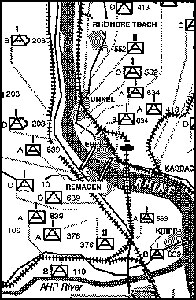 |
On March 14,
eleven Ar-234s
turned their
attention to
the newly
constructed
ponton bridge
south of the
Ludendorff
Bridge. The
Luftwaffe jets
encountered
withering
flak, and if
that was not
enough, they
were pounced
by RAF
Tempests and
Spitfires,
along with
long-range US
aircraftP-38s
and P-51s. At
least 5 German
aircraft were
downed. On
March 15,
twenty-one
German jet
aircraft
attacked the
bridge with
poor results.
US
anti-aircraft
batteries shot
down more than
half of these
fast-moving
aircraft. The
defense of the
Remagen Bridge
ranks as one
of the
greatest
Antiaircraft
Artillery
battles in
American
history.
Engineers of the 276th
Engineer Combat Battalion and of the
1058th Port Construction and Repair
Detachments were required to make repairs
to the bridge. After its capture on March
7th, the steel-girder construction
suffered stress from the German artillery
fire and from the bombardment by the
Luftwaffe. Added to this were the shocks
caused by American heavy artillery nearby
and the heavy equipment brought onto the
bridge.
Over these ten days the soldiers billeted in Remagen and on the east bank were not only witness to the German efforts in the sky, but also to the heavy artillery barrage slung by the Germans into the bridgehead. Over 100 pieces of artillery including 150mm light howitzers, along with heavy 210mm howitzers, ringed the southeastern edge of the bridgehead and caused many a G.I. to shudder as shells landed west of the Rhine. The greatest damage was done in the town of Remagen, as the combat troops east of the Rhine in the bridgehead were relatively well-protected by the steep Erpeler Ley.

Photos
below: American troops and
armor across the Rhine. The
heavy M26 Pershing tanks had
to be ferried across,
while the lighter-weight
Sherman tanks could cross over
the planking laid on the
Ludendorff Bridge.
(CLICK ON THUMBNAIL TO ENLARGE)
 |
 |
 |
 |
 |
 |
 |
 |
 |
 |
 |
 |
 |
 |
 |
 |
 |
 |
 |
 |
 |
 |
 |
 |

Hitler
was incensed that the Americans had not been
repelled by conventional forces. He ordered
all available means of attack to be directed
at the bridge, even the eccentric. The
bridgehead was bombarded by a
17-centimeter railway-mounted
artillery gun (drawn
up on the
southeastern edge
of the bridgehead);
new jet aircraft such as the Arado AR-234B
and the Messerschmitt ME-262 fighter-bomber;
the use of underwater
scuba men (they were to swim down the Rhine in
an attempt to place demolitions on the piers);
and finally V-2 rockets to strike the
bridgehead area. Even though the bridge was
probably the aiming point for the V-2 attacks,
Hitlers objective was not to strike the
bridge so much as it was to disrupt the whole
area with the rocket attacks. Hitler was sure that
his V-2s would cauterize the
whole bridgehead area. He
envisioned 50100 missiles over a two or
three-day period, but at this point in the war
there was no way the rocket troops could
muster such an effort.
V-2s on
Remagen
On March 16 the
Germans began their
strongest effort yet
to bring down the
Ludendorff bridge.
That morning shells
larger than 88mm came
over and on March 17
several giant
projectiles from the
tank mounted piece
called the Karl
howitzer landed in
Remagen. Commander of
the German rocket
forces, SS General
Kammler, received orders
to attack Remagen and
immediately issued
commands to the SS 500
crews at Hellendoorn,
130 miles to the north
of Remagen, to fire on
the American bridgehead.
The
SS 500
had been
firing since
March 8 from
the older
launch sites
at Hellendoorn in the Netherlands. Despite fuel
supply
problems, the
troops were
able to muster
11 rockets for
the attack on
March 17,
1945. If the
unit was given
the assignment
because of
their
new
employment of
the guide-beam
equipment, the
decision was
erroneous. The
new Leitstrahl
apparatus
could not be
used for the
attacks on
Remagen
because the
installation
was already
situated for
semi permanent
operations in
the direction
of Antwerp; it
could not be
moved on such
short notice.
Nonetheless,
the crews
began firing
at 9:45 AM and
continued
throughout the
day until the
eleventh round
tilted toward
Remagen around
9:45 PM. All
hit near
Remagen except
for one, which
came down some
40 kilometers
away near
Cologne.
|
|
For the
Americans
fighting in
the
bridgehead,
the sight of
V-2s rising in
the distance
wasn't
uncommon. The
difference
being, these
rockets were
being fired at
Antwerp from
rocket troops
positioned in
Westerwald
forest to the
east. Anti-aircraft observers scanning
the skies for
enemy aircraft
over Remagen
had been able
to spot the
V-2s rising
from Battalion
836 (Art. Reg.
901) at Hachenburg and watched as the rockets passed
overhead on
the way to
Antwerp. 413th
AAA battery's
observer
spotted two
more being
launched on
March 16 and
watched as
they tore out
of sight into
the
atmosphere:
"At
approximately
6:15 AM a
vapor trail,
rising
vertically
from the
ground was
observed
through a
director
telescope,
while a net
message was
being run.
Around 6:45 AM
the same was
observed
again. It was
believed that
the trails
were from
V-2s." The last rocket from Hachenburg area was launched
around 3:00 PM
on March 16,
1945. The
failing supply
of rocket fuel
and Allied
advance at
Remagen,
caused Battalion 836 (Art. Reg. 901) to be the first
V-2 launching
unit to halt
operations. Of the eleven rockets fired from Holland on March 17, 1945, the first round ended up landing closest to the bridge. Just before impact the missile broke up (air-burst) over Kasbach (just southeast of bridge) and scattered rocket parts over a wide area of the town. Parts of the rocket motor crashed through the roof of the house belonging to Kasbach resident Christian Schützeichel. Debris smashed into Erpeler Ley and the combustion chamber was buried in the hillside. |
The warhead came down around 9:54 AM in the backyard of a house belonging to a farmer named Herman Joseph Lange. This farm was 500-800 yards south/southeast of the Ludendorff bridge. A dozen US soldiers were billeted in this house; three of them were killed instantly. In the short time the Americans had been staying at the home of Joseph Lange, the family had already become close to the men, some who were now dead. The rocket impact, so close to the bridge, shook the ground with a tremendous boom and mini-earthquake. In the explosion 18 farm animals were also killed. The incoming missile had been seen and tracked by anti-aircraft observers near the bridge -- "At 09:55 hours, while tracking two German planes, at 9500 ft, flying west to east, AAA units observed an object resembling fast-moving bomb pass across the track of telescopes. The object fell in a direction east to west with large explosion, producing at least two loud booms. Several pieces of aluminum scrap fell, some in our battery position."
|
Later, Hitler turned his wrath on anyone deemed to be responsible for allowing the Ludendorff Bridge to be captured by the Americans. Hitler sacked Gerd von Rundstedt, commander in chief in the West, replacing him with Field Marshal Albert Kesselring. A hurried Nazi court-martial chaired by Lt. General Rudolph Hübner found five officers guilty of cowardice and dereliction of duty and sentenced them to death. Four of these, Maj. Scheller, Lt. Karl Heinz Peters, Maj. Herbert Strobel, and Maj. August Kraft, faced the firing squad on the day of their sentencing in the Westerwald (two in Rimbach, two in Oberirsen). A sixth officer, Capt. Friesenhahn was exonerated, as the court found that he had done everything within his powers to destroy the bridge, not that it mattered as he had been captured by the Americans. Their families' pension rights were revoked, but then they were reinstated after the defeat of Nazi Germany. The fifth officer, Captain Bratge, was convicted and sentenced in absentia, since he had been captured by the US Army by that time. For their part in the battle, Timmermann and DeLisio, along with 13 others, received the Distinguished Service Cross. The Silver Star was earned by 152 American soldiers. All units that comprised Combat Command B of the 9th Armored Division received Presidential Unit Citations. US President Eisenhower later said the names of the brave men participating in the battle to Remagen should be in a permanent place in the niche of fame at the seat of the American government. A large sign was placed on one of the stone towers of the Ludendorff Bridge (see photos below) by C Co, 9th Armored Engineer Battalion, marked "CROSS THE RHINE WITH DRY FEET COURTESY OF 9TH ARM'D DIV". The sign is now on display at the George Patton Museum of Cavalry and Armor, at Fort Knox, Kentucky. |
Sources and References:
|

Photos
below: Some of the unconventional
German weaponry thrown
into action against American bridgehead at
Remagen.
(CLICK ON
THUMBNAIL TO ENLARGE)
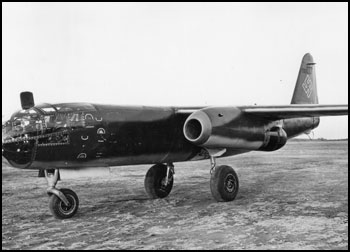 Arado Ar-234 jet-bomber |
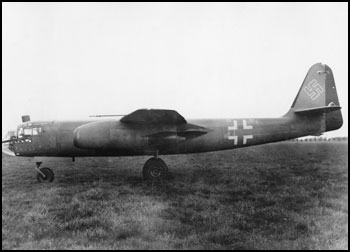 Arado Ar-234 jet-bomber |
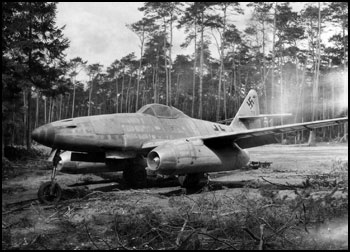 Messerschmitt Me-262 jet fighter-bomber |
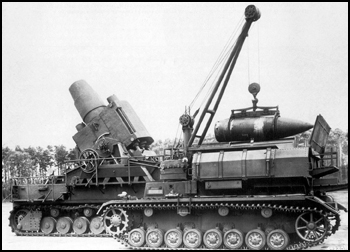 Karl Mörser 54cm s-p gun |
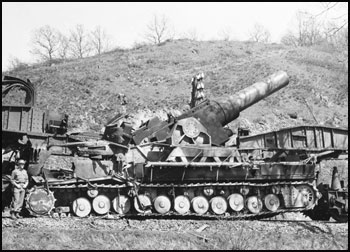 Karl Mörser 54cm following capture by 1st Army |
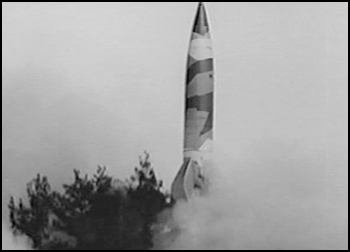 V-2 rockets launched from Netherlands |

Timeline V-2 attacks on Remagen March 17, 1945
Mar. 17, (09.48 hours) - Batt. SS Abt. 500, Hellendoorn, Site 412 (Eelerberg - second period), V-2 rocket fired, Target Remagen. Disintegrated in the air near Kasbach. Parts from the rocket turbine penetrated the roof of a house; other parts fell on Erpeler Ley and on a farm 800m from the Ludendorff Rail Bridge injuring 18 farm animals. Warhead impacted 300m from the bridge, shaking it very strongly. Three American soldiers killed. (Detlev Paul, Wolfgang Gückelhorn)Mar. 17, (10.29 hours) - Batt. SS Abt. 500, Hellendoorn, Site 412 (Eelerberg - second period), V-2 rocket fired, Target Remagen. Impacted approximately 8km WNW of the bridge, south of Birresdorf. Impacted approximately 8km ENE of bridge. Map Reference F-579211. (John Pridige)Mar. 17, (12.16 hours) - Batt. SS Abt. 500, Hellendoorn, Site 412 (Eelerberg - second period), V-2 rocket fired, Target Remagen. Impacted in the western district of Remagen. The command post for Company B of the 284th Engineer Combat Battalion was hit, killing three soldiers and injuring thirty-one others. Map Reference F-636203. (Mikel Shilling, Detlev Paul, Wolfgang Gückelhorn)Mar. 17, (15.15 hours) - Batt. SS Abt. 500, Hellendoorn, Site 412 (Eelerberg - second period), V-2 rocket fired, Target Remagen. Impacted approximately 7km WNW of the bridge, 300m from the parish church of Nierendorf which suffered widespread damage to windows. (Detlev Paul, Wolfgang Gückelhorn)Mar. 17, (15.43 hours) - Batt. SS Abt. 500, Hellendoorn, Site 412 (Eelerberg - second period), V-2 rocket fired, Target Remagen. Impacted in Odingen, approximately 7km NW of the bridge, destroying several houses. Six people died and many others including American soldiers were wounded. Apollinaris Church Archives. Map Reference (within 5km of F-6022) MR: WF 590233. (Detlev Paul, Wolfgang Gückelhorn)Mar. 17, (17.49 hours) - Batt. SS Abt. 500, Hellendoorn, Site 412 (Eelerberg - second period), V-2 rocket fired, Target Remagen. Impacted approximately 6km WNW of the bridge, around 1.5km NE of Nierendorf. (John Pridige)Mar. 17, (18.15 hours) - Batt. SS Abt. 500, Hellendoorn, Site 412 (Eelerberg - second period), V-2 rocket fired, Target Remagen. Exploded in the air south-west of Heimersheim. (Detlev Paul, Wolfgang Gückelhorn)Mar. 17, (18.29 hours) - Batt. SS Abt. 500, Hellendoorn, Site 412 (Eelerberg - second period), V-2 rocket fired, Target Remagen. Disintegrated in the air NNW of Strodt, approximately 9km NE of the bridge and in German-held territory. (Detlev Paul, Wolfgang Gückelhorn)Mar. 17, (20.20 hours) - Batt. SS Abt. 500, Hellendoorn, Site 412 (Eelerberg - second period), V-2 rocket fired, Target Remagen. Impacted some 40km short of its target in Staatsforst Konigsforst, east of Koln. (John Pridige)Mar. 17, (20.55 hours) - Batt. SS Abt. 500, Hellendoorn, Site 412 (Eelerberg - second period), V-2 rocket fired, Target Remagen. Impacted approximately 4km WSW of the bridge, near Kirchdaun. (John Pridige)Mar. 17, (21.45 hours) - Batt. SS Abt. 500, Hellendoorn, Site 412 (Eelerberg - second period), V-2 rocket fired, Target Remagen. Impacted approximately 9km WNW of the bridge. (John Pridige)

284th Combat Engineers Battalion, 1159th Group, 3rd Corps, 3rd US Army
284th Engineer Combat Battalion
Caught up in the race to the Rhine was one American engineer battalion that would become embroiled in V-2 rocket lore on March 17, 1945. The 284th Combat Engineers Battalion had been in England since November of 1944 completing their training on bridge, road repair, and construction. In early January 1945 the battalion left Camp Delemere Park in England and arrived at Camp Twenty Grand, located approximately forty miles east of Le Havre. This camp consisted of thousands of six-man pyramidal tents set up as a staging area, where, newly arrived GIs would be assigned their duties in the ETO. On January 25, 1945, the battalion traveled to Moutfort in Luxembourg for infantry training.
Although the 284th was part of the 3rd US Army, in Luxembourg the battalion was transferred to 1st Army's front line near the Hürtgen Forest, which was then resting on the flooded Röer River. From February 4-15 the battalion occupied defensive positions along Moselle near Remich (used as infantry by 2nd Cavalry) and then later, positions along Our River guarding Skyline Drive near Kocherey (used as infantry by 6th Armored Division). Once the waters of the flooded Röer River subsided, the Lumberjack offensive was launched.
On February 26, 1945, 284th Company C built a Bailey bridge at Kreuzau, under artillery and small arms fire, that put the 9th Armored Division (Combat Command B) rolling onto the Rhine Plain. This was the longest bailey bridge in the ETO to date. It was 254-foot-long, built on the remnants of arches from a bridge that the Germans had demolished. The Germans had blown the dams in the river upstream so the engineers had to wait for the water to recede and they soon discovered the area littered with mines. During this drive the 284th was also assigned as infantry to support the 9th Armored.
B Company and C Company of the 284th stuck with the 9th Armored all the way into Remagen. The recon portion of 284th had been with CCB the afternoon before they reached the Rhine and took the bridge.
Two jeep loads of 284th headquarters officers crossed the bridge late in the morning on March 8 to examine its condition, considering the blasts it had suffered. Sometime after March 8 the 284th engineers took up positions on Apollinarisberg (road) overlooking the Rhine River on the west bank. The 284th was billeted in the houses next to the ancient Apollinaris Church.(CLICK ON THUMBNAIL TO ENLARGE)
 |
 |
 |
 |
 |
| Located
on a hill over-looking the Rhine
River on the west bank was the
centuries-old church,
Apollinariskirche. Built on the
site of a former Roman temple, the
great spires of the church were
visible for miles. The hill above
the town of Remagen was known as
the Martinsberg in the 5th and 6th
centuries, presumably after a
Frankish chapel there dedicated to
Saint Martin, patron of the
Franks. In the 9th century this chapel was replaced by a Romanesque church. In 1110 the Benedictines of the Michaelsberg Abbey, on the initiative of the people of Remagen, set up a provost there. The relics of Saint Apollinaris of Ravenna probably arrived on the mountain at the end of the 14th century, since a pilgrimage to the Apollinarisberg is recorded in 1384. The sarcophagus is the main relic in the 14th century crypt of the church. A new Neo-Gothic church was built on the site from 1837 to 1852. Relics of St Apollinaris were brought to this city in the 12th century. In 1383 all of these relics, except the skull, were stolen by Duke Wilhelm I and brought to Düsseldorf, Germany. The skull was kept for the next few centuries in several different locations including for a time in Düsseldorf; however, in 1857 it was returned to Remagen where it remains to this day. It rests within a magnificent reliquary bust placed within a large sarcophagus in the crypt of this church. Twice a year this bust is removed for the blessing of pilgrims. The old church, with its four spires rising high into the air over Remagen, was an obvious landmark for the flood American troops funneling towards the bridge. The engineers of the 284th were billeted in the houses below the church. There, they would maintain the roads leading down into Remagen for the thousands of troops and vehicles heading for the Rhine crossing. |
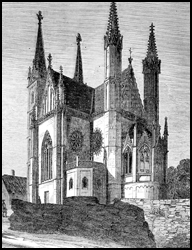 |
Below:
Period photos showing Apollinariskirche.
(CLICK ON THUMBNAIL TO
ENLARGE)
 |
 |
 |
 |
 |
 |
Click here
to view a modern panoramic 360-degree
image of the Rhine River as seen from
Apollinaris Church.
This is the same vantage
point as the men from 284th
Combat Engineers Battalion had in
1945.
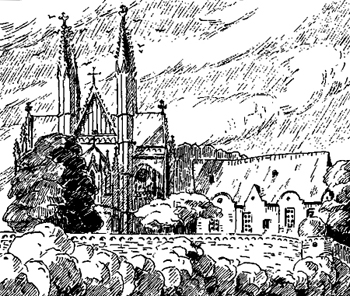 |
B and C
Company Command Posts of the
284th Engineer Combat Battalion
were situated on the Martinsberg
Hill just NW of the town. This
was the "Rhine Wine" vineyard,
lower slope, not yet in bloom
because it was early March. The 284th's
location was not inside the town
of Remagen proper, but just
outside, above
the railway line on the west
bank next to the church. B Company set up their Command post in a building at Apollinarisberg No. 7, situated directly across from the church. The building had long been an old inn named "Gasthaus zum St. Josef A. Schlich." The guest house served as a meeting point over the years for the faithful making pilgrimages to Apollinaris Church. The building was multi-storied, and as most houses of that period, it had a basement. C Company's command post was located at the east end of Apollinarisberg, near the curve of the road Birresdorfer Strasse. The building was next to a large vineyard, that was below the church, on one of the last hills before the river bank. The 3rd Platoon of C Company was staying in a house further down Birresdorfer Strasse. This was called a house of "mystery" as there were supposed to be caves that stored military secrets, in the cellar or the grounds nearby. A certain Lt. Col. Holtz, an SS Trooper, had formerly occupied the house. Since the capture of the Ludendorff Bridge on March 7, the men of the 284th had been busy maintaining the roads on the west bank of Remagen for the thousands of vehicles moving towards the Rhine crossing. They had been subject to artillery attacks from the Germans and had witnessed the desperate Luftwaffe air attacks in the days following the capture of the bridge. |
On
the morning on March 17, 1945, the
Germans fired even larger shells than
the usual 88mm. Several rounds of
giant 60cm projectiles from a
tank-mounted piece called the Karl
Mörser (howitzer) landed in Remagen.
From their
positions higher up by the church, the
soldiers of the 284th had a clear view
of the river, the bridge, and the town
of Remagen. They could see the
engineers of the 51st and 291st Combat
Engineer Battalions below and had
watched the construction of the ponton
bridges across the river. The German
artillery could be seen landing near
the bridge and in Remagen. Later that
afternoon, the men of the 284th
Combat Engineers Battalion would soon
meet the largest piece of German
artillery.
Below:
Pre-war photos. View from Apollinaris
Church of
Rhine River, Ludendorff Bridge, and
town of Remagen.
(CLICK
TO ENLARGE)
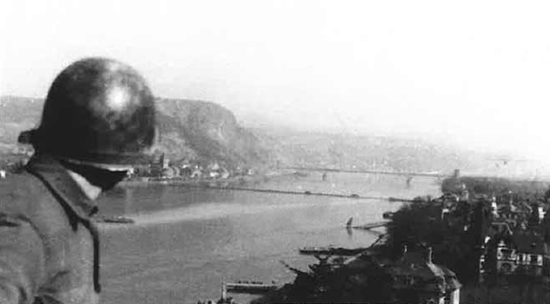 |
Edmund
MacNeil Jr., Headquarters and
Service Company of the 284th,
wrote about the V-2 strikes of
March 17, 1945, near the river. He
explained; on that morning he was
in a jeep with Lt. Hochberger on
the hill up by Apollinaris. They
were looking out towards the river
at all the activity near the
bridge. One of the men snapped the
photo on the left. At 9:54 AM, the first V-2 strike came down on the Erpeler Ley hillside on the east bank. The two men watched it bring up quite a bit (soil) of the hill, like an expansion of earth. They then drove down into Remagen, crossed the ponton bridge, and climbed the hill to observe the damage. They found the rocket motor in an upright position with reddish liquid (alcohol) dripping from it. The two men looked it over, but soon MP's, who came quickly, seemingly from nowhere, closed off the area. MacNeil and Hochberger returned to their jeep and crossed back to the west bank. They drove back up near Apollinaris church to finish some battalion business, and when completed, they drove further down the river and west to Arwheiler. It was only minutes after they left the area, B Company CP was hit by another V-2. |
Probably
what MacNeil witnessed was a V-2
"air-burst," which is, an explosion of
the fuel tanks just before impact. This
would have scattered the rocket parts
over a wide area (assuming the rocket
was at a sufficiently high altitude) and
would have allowed the warhead to impact
in a conventional manner as it did.
Parts from this rocket were found all
over the area near the bridge and
Kasbach.
|
The V-2 that hit 284th
Combat Engineers Battalion
B Company Command Post
came down around 12:20 PM.
Some of the men were
gathering at this location
for lunch. 1st Lt. John
Ripandelli was a Staff
Officer with S2 section of
the 284th. He was a
Reconnaissance Officer
(with his own jeep) and
saw a lot of the
bridgehead area as he
traveled ahead of the
battalion. Ripandelli had
been invited by Captain
Henry, if ever on a recon
in the area, to drop in
for lunch some day. When
Ripandelli arrived the
Captain said lunch wasn't
quite ready. He suggested
that Ripandelli should
take a hike up the hill to
see a famous old Church
while waiting. Just as
"Rip" had just reached the
top of the hill, the V-2
struck farther down, right
on the command post while
lunch was being prepared. Ripandelli remembered, "I saw a very faint, almost unnoticeable, fast-moving contrail as it came in. I had just reached the top of the hill to visit the lone church up there and had turned to catch my breath and looked over my shoulder at the Rhine far below when I saw this movement in the air. It lasted only a second before the area of the command post farther down the slope went up in a cloud of smoke, thrown up soil and building debris. Then, I simply don't recall a damn thing." At the moment of impact the "Gasthaus" at Apollinarisberg No. 7 collapsed upon itself. The occupants on the first floor were thrown down in the basement. This V-2 strike also destroyed several other buildings near the church and caused collateral damage to buildings within 1,000 meters. The impact shook every structure in the city. The heavy rocket motor combustion chamber bounded 300 feet eastward and crashed into a shed near the cottages where C Company was billeted. A soldier was in the shed reading at the time, but was not injured. 19-year-old 284th soldier Elliot Rose was a member of B Company. On the morning of March 17, Rose was stationed in the back of a truck while manning a .50 caliber machine gun in the courtyard of the Apollinaris church. Looking out at the Rhine from this vantage point Rose remembered a sudden flash. At the moment of impact on the B Company CP he was knocked from his feet. Rose, who was a few hundred yards away from the impact, said the blast left him stunned and unable to speak for several hours. He and the others from his unit went through the motions of cleaning up while dazed. He remembers the shock wave was so tremendous, every house in Remagen shook and took damage. Rose commented, saying in his opinion, the thunderous V-2 impacts that morning were responsible for the Ludendorff collapse a few hours later. Many of the men from the 284th were not altogether unfamiliar with V-bomb strikes. Before disembarking to ETO many had experienced the sounds of V-2s hitting London. However, this was differentthese were their buddies. Members of first and second platoon of C Company, who were billeted several houses down to the east, near the curve of the road, immediately came to the aid of their B Company brethren. Soon help was arriving from various units and heavy lifting equipment was brought in to remove the debris. - |
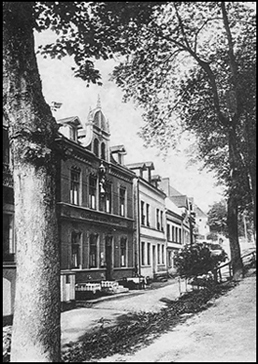 - Photo
above
is from
Apollinarisberg 1935:
Located on
Apollinarisberg No. 7,
parallel to the road
Birresdorfer Strasse,
stood the old inn
named "Gasthaus zum
St. Josef A. Schlich."
It was a meeting place
for the faithful,
especially during the
St. Apollinaris
pilgrimages. B Company
US 284th Engineer
Combat Battalion was
billeted here when a
V-2 strike destroyed
the building on March
17, 1945. |
First Army broke out of the bridgehead and 284th Engineer Combat Battalion, attached to an armored division as supporting infantry, headed north to meet up with the 9th US Army coming south to close the so called "Rhur Pocket." The 1st Army and 9th Army met outside Paderborn on April 1. When the operation was over they had captured around 350,000 German prisoners. On May 1, 1945, they laid Bailey bridges across the Isar and Altmul rivers and assisted with liberating various forced labor camps.
HEADQUARTERS
284TH ENGINEER COMBAT
BATTALION
APO 230 U.S. ARMY
22 MARCH 1945
SUBJECT: Report on V-2.
TO: First Army, APO 230
Attn: PAD section.
There were five officers and ten EM billeted in the CP building. Eight persons were in the building at the time of the explosion.
The second building east was the quarters of the First Platoon, two squads of which were present. As the smoke and dust cleared, it revealed members of the First Platoon evacuating or being evacuated from their building. The junction of the main road and Church Drive was designated as the point for all casualties to gather. A pair of 2.5-ton dump trucks were summoned to the point to remove the casualties.
A jeep was sent to Charlie Company to get aid men. At approximately 12:35 one ambulance, a medical officer, and three aid men arrived from 1111 Engineer (C) Group. They immediately began giving first aid.
The explosion had brought many soldiers to the scene. They were informed that approximately six men were in the fallen building, and were immediately put to work removing the debris to get to the men inside. Just as they started, the Company Commander, Capt. Thomas C. Henry climbed out. He had dug himself out. He said there were several men inside and encouraged the men to dig quickly.
A winch from a 2.5-ton dump truck was used to raise a large piece of the building so they could get beneath it to the men inside.
By this time all the men had been evacuated from the First Platoon building, given first aid, tagged and were either on the first 6x6 or in the ambulance. They were escorted to the 102d Evacuation Hospital by an MP officer on a motorcycle. This group of men included the first man removed from the building.
The next person removed from the debris was the 1st Sergeant and he was taken to the 9th Armoured Aid Station in Remagen on the jeep of one of the Company Platoon Commanders. This Officer upon his return brought two ambulances from the aid station.
As soon as first aid had been given to all the casualties, the medical officer from Group went up to the church to an AA gun position and injected members of that gun crew. He was then escorted to the quarters of zone AA members that were west of and across the road from the explosion. Six members of Baker Company were in that building and had been given first aid. They were all well taken care of, covered tagged and ready to be evacuated. An ambulance was summoned to that building and they were evacuated to the 102 Evacuation Hospital.
The Group medical officer then returned to the scene and was ready to give immediate first aid as the men were pulled from the wreckage. A major of the medical Corps was present and up to this time had been caring for the men as they were taken from the wreckage.
At approximately 15:30 hrs the eighth and final person removed was Lt. Louis F. Saas, Jr., First Platoon Commander. The Company Commander dug himself out. Seven were dug out. Two were dead, four injured and one died from head wound in route to the hospital. Six of the wounded returned to duty that evening.
During the operation a bulldozer was brought up, but was not used since we didn't know the exact location of the bodies beneath the debris. This incident has been the topic of conversation since, and I feel that under the circumstances, the control and caring for the wounded was exceptionally good.
CHARLES W. FINGER
1st Lt. CE
Commanding Co. B
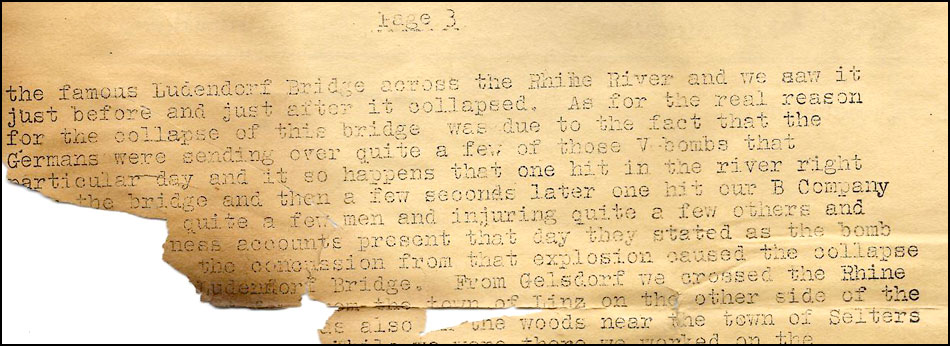
Above:
Men of B Company 284th Combat Engineer
Battalion.
(CLICK TO ENLARGE)
Photos below: Contemporary photos of
Apollinaris Church and the houses on
Apollinarisberg. Today the "re-built"
house, or
"the house with black tiles,"
Apollinarisberg No. 7, is known as the
place where the V-2 came down.
(CLICK
ON THUMBNAIL TO ENLARGE)
 |
 |
 |
 |
 |
 |
 |
 |
 |
 |
 |
 |
 |
 |
 |
 |
 |
 |



"The Big Picture" (US Army) from late 1950s aired
this comprehensive film with the best footage and
interviews from the
veterans who were there in Remagen in 1945. Below
is this film in two parts. Click in lower right
corner of each clip to view full-screen.
Peace Museum
Remagen 
Opening
hours:
March 7 - November 16
Daily 10 AM - 5 PM
May through October 6 PM
